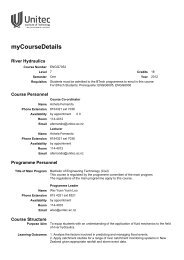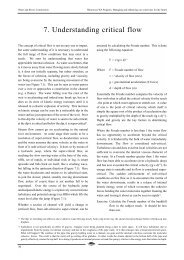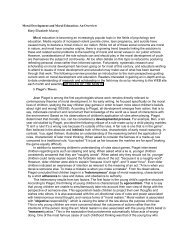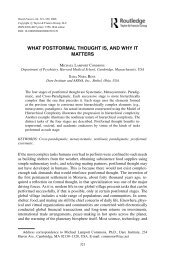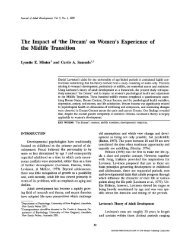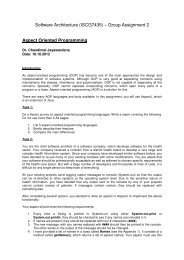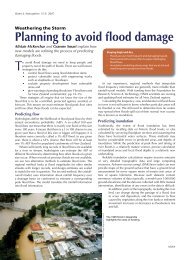10 Top Photography Composition Rules | Photography Mad
10 Top Photography Composition Rules | Photography Mad
10 Top Photography Composition Rules | Photography Mad
You also want an ePaper? Increase the reach of your titles
YUMPU automatically turns print PDFs into web optimized ePapers that Google loves.
<strong>10</strong> <strong>Top</strong> <strong>Photography</strong> <strong>Composition</strong> <strong>Rules</strong> | <strong>Photography</strong> <strong>Mad</strong><br />
11/04/13 9:29 AM<br />
Tips<br />
About<br />
Contact<br />
<strong>10</strong> <strong>Top</strong> <strong>Photography</strong> <strong>Composition</strong> <strong>Rules</strong><br />
There are no fixed rules in photography, but there are guidelines which can often help you to enhance the<br />
impact of your photos.<br />
Beautiful Wedding Album<br />
PhotoBook.co.nz/Wedding_PhotoBooks<br />
Easy to make, stunning wedding photo book<br />
album for under $<strong>10</strong>0<br />
Advertise On Google<br />
www.google.com/nz/adwords<br />
Get website traffic using AdWords. Spend $25,<br />
Get $<strong>10</strong>0 Bonus Credit!<br />
NZ Event Photographer<br />
www.cactusphotography.co.nz<br />
Specialize in Corporate events, Awards and<br />
Gala Dinners<br />
<strong>Photography</strong> Courses<br />
www.The<strong>Photography</strong>Institute.co.nz<br />
Become a Successful Photographer. At Home at<br />
your own Pace. Start Now<br />
It may sound clichéd, but the only rule in photography is that there are no rules. However, there are are<br />
number of established composition guidelines which can be applied in almost any situation, to enhance<br />
the impact of a scene.<br />
These guidelines will help you take more compelling photographs, lending them a natural balance,<br />
drawing attention to the important parts of the scene, or leading the viewer's eye through the image.<br />
Once you are familiar with these composition tips, you'll be surprised at just how universal most of them<br />
are. You'll spot them everywhere, and you'll find it easy to see why some photos "work" while others feel<br />
like simple snapshots.<br />
Rule of Thirds<br />
Imagine that your image is divided into 9 equal segments by 2 vertical and 2 horizontal lines. The rule of<br />
thirds says that you should position the most important elements in your scene along these lines, or at the<br />
points where they intersect.<br />
Doing so will add balance and interest to your photo. Some cameras even offer an option to superimpose<br />
http://www.photographymad.com/pages/view/<strong>10</strong>-top-photography-composition-rules<br />
Page 1 of 13
<strong>10</strong> <strong>Top</strong> <strong>Photography</strong> <strong>Composition</strong> <strong>Rules</strong> | <strong>Photography</strong> <strong>Mad</strong><br />
11/04/13 9:29 AM<br />
a rule of thirds grid over the LCD screen, making it even easier to use.<br />
Notice how the building and horizon are aligned along rule-of-thirds lines. Image by Trey Ratcliff.<br />
Balancing Elements<br />
Placing your main subject off-centre, as with the rule of thirds, creates a more interesting photo, but it can<br />
leave a void in the scene which can make it feel empty. You should balance the "weight" of your subject<br />
by including another object of lesser importance to fill the space.<br />
http://www.photographymad.com/pages/view/<strong>10</strong>-top-photography-composition-rules<br />
Page 2 of 13
<strong>10</strong> <strong>Top</strong> <strong>Photography</strong> <strong>Composition</strong> <strong>Rules</strong> | <strong>Photography</strong> <strong>Mad</strong><br />
11/04/13 9:29 AM<br />
Here, the visual "weight" of the road sign is balanced by the building on the other side of the shot. Image<br />
by Shannon Kokoska.<br />
Leading Lines<br />
When we look at a photo our eye is naturally drawn along lines. By thinking about how you place lines in<br />
your composition, you can affect the way we view the image, pulling us into the picture, towards the<br />
subject, or on a journey "through" the scene. There are many different types of line - straight, diagonal,<br />
curvy, zigzag, radial etc - and each can be used to enhance our photo's composition.<br />
http://www.photographymad.com/pages/view/<strong>10</strong>-top-photography-composition-rules<br />
Page 3 of 13
<strong>10</strong> <strong>Top</strong> <strong>Photography</strong> <strong>Composition</strong> <strong>Rules</strong> | <strong>Photography</strong> <strong>Mad</strong><br />
11/04/13 9:29 AM<br />
The road in this photo draws your eye through the scene. Image by Pierre Metivier.<br />
Symmetry and Patterns<br />
We are surrounded by symmetry and patterns, both natural and man-made., They can make for very eyecatching<br />
compositions, particularly in situations where they are not expected. Another great way to use<br />
them is to break the symmetry or pattern in some way, introducing tension and a focal point to the scene.<br />
http://www.photographymad.com/pages/view/<strong>10</strong>-top-photography-composition-rules<br />
Page 4 of 13
<strong>10</strong> <strong>Top</strong> <strong>Photography</strong> <strong>Composition</strong> <strong>Rules</strong> | <strong>Photography</strong> <strong>Mad</strong><br />
11/04/13 9:29 AM<br />
The symmetry of this chapel is broken by the bucket in the bottom right corner. Image by Fabio Montalto.<br />
Viewpoint<br />
Before photographing your subject, take time to think about where you will shoot it from. Our viewpoint<br />
has a massive impact on the composition of our photo, and as a result it can greatly affect the message<br />
that the shot conveys. Rather than just shooting from eye level, consider photographing from high above,<br />
down at ground level, from the side, from the back, from a long way away, from very close up, and so on.<br />
http://www.photographymad.com/pages/view/<strong>10</strong>-top-photography-composition-rules<br />
Page 5 of 13
<strong>10</strong> <strong>Top</strong> <strong>Photography</strong> <strong>Composition</strong> <strong>Rules</strong> | <strong>Photography</strong> <strong>Mad</strong><br />
11/04/13 9:29 AM<br />
The unusual viewpoint chosen here creates an intriguing and slightly abstract photo. Image by ronsho.<br />
Background<br />
How many times have you taken what you thought would be a great shot, only to find that the final image<br />
lacks impact because the subject blends into a busy background? The human eye is excellent at<br />
distinguishing between different elements in a scene, whereas a camera has a tendency to flatten the<br />
foreground and background, and this can often ruin an otherwise great photo. Thankfully this problem is<br />
usually easy to overcome at the time of shooting - look around for a plain and unobtrusive background<br />
and compose your shot so that it doesn't distract or detract from the subject.<br />
http://www.photographymad.com/pages/view/<strong>10</strong>-top-photography-composition-rules<br />
Page 6 of 13
<strong>10</strong> <strong>Top</strong> <strong>Photography</strong> <strong>Composition</strong> <strong>Rules</strong> | <strong>Photography</strong> <strong>Mad</strong><br />
11/04/13 9:29 AM<br />
The plain background in this composition ensures nothing distracts from the subject. Image by Philipp<br />
Naderer.<br />
Depth<br />
Because photography is a two-dimensional medium, we have to choose our composition carefully to<br />
conveys the sense of depth that was present in the actual scene. You can create depth in a photo by<br />
including objects in the foreground, middle ground and background. Another useful composition<br />
technique is overlapping, where you deliberately partially obscure one object with another. The human<br />
eye naturally recognises these layers and mentally separates them out, creating an image with more depth.<br />
http://www.photographymad.com/pages/view/<strong>10</strong>-top-photography-composition-rules<br />
Page 7 of 13
<strong>10</strong> <strong>Top</strong> <strong>Photography</strong> <strong>Composition</strong> <strong>Rules</strong> | <strong>Photography</strong> <strong>Mad</strong><br />
11/04/13 9:29 AM<br />
Emphasise your scene's depth by including interesting subjects at varying distances from the camera.<br />
Image by Jule Berlin.<br />
Framing<br />
The world is full of objects which make perfect natural frames, such as trees, archways and holes. By<br />
placing these around the edge of the composition you help to isolate the main subject from the outside<br />
world. The result is a more focused image which draws your eye naturally to the main point of interest.<br />
http://www.photographymad.com/pages/view/<strong>10</strong>-top-photography-composition-rules<br />
Page 8 of 13
<strong>10</strong> <strong>Top</strong> <strong>Photography</strong> <strong>Composition</strong> <strong>Rules</strong> | <strong>Photography</strong> <strong>Mad</strong><br />
11/04/13 9:29 AM<br />
Here, the surrounding hills form a natural frame, and the piece of wood provides a focal point. Image by<br />
Sally Crossthwaite.<br />
Cropping<br />
Often a photo will lack impact because the main subject is so small it becomes lost among the clutter of<br />
its surroundings. By cropping tight around the subject you eliminate the background "noise", ensuring the<br />
subject gets the viewer's undivided attention.<br />
http://www.photographymad.com/pages/view/<strong>10</strong>-top-photography-composition-rules<br />
Page 9 of 13
<strong>10</strong> <strong>Top</strong> <strong>Photography</strong> <strong>Composition</strong> <strong>Rules</strong> | <strong>Photography</strong> <strong>Mad</strong><br />
11/04/13 9:29 AM<br />
Cut out all unnecessary details to keep keep the viewer's attention focused on the subject. Image by Hien<br />
Nguyen.<br />
Experimentation<br />
With the dawn of the digital age in photography we no longer have to worry about film processing costs<br />
or running out of shots. As a result, experimenting with our photos' composition has become a real<br />
possibility; we can fire off tons of shots and delete the unwanted ones later at absolutely no extra cost.<br />
Take advantage of this fact and experiment with your composition - you never know whether an idea will<br />
work until you try it.<br />
http://www.photographymad.com/pages/view/<strong>10</strong>-top-photography-composition-rules<br />
Page <strong>10</strong> of 13
<strong>10</strong> <strong>Top</strong> <strong>Photography</strong> <strong>Composition</strong> <strong>Rules</strong> | <strong>Photography</strong> <strong>Mad</strong><br />
11/04/13 9:29 AM<br />
Digital photography allows us to experiment with different compositions until we find the perfect one.<br />
Image by Jule Berlin.<br />
<strong>Composition</strong> in photography is far from a science, and as a result all of the "rules" above should be taken<br />
with a pinch of salt. If they don't work in your scene, ignore them; if you find a great composition that<br />
contradicts them, then go ahead and shoot it anyway. But they can often prove to be spot on, and are<br />
worth at least considering whenever you are out and about with your camera.<br />
Did you find this post helpful? If so, please spread the word by sharing it below.<br />
Like 5.2k 799 Tweet 662 1.1K<br />
You Might Also Like<br />
5 Keys to Finding the Perfect Portrait Location<br />
Using Focus Lock on Your Digital Camera<br />
Photographing Water Drops<br />
The 3 Best Lens Filters for Landscape <strong>Photography</strong><br />
Shutter Speed: A Beginner's Guide<br />
http://www.photographymad.com/pages/view/<strong>10</strong>-top-photography-composition-rules<br />
Page 11 of 13
<strong>10</strong> <strong>Top</strong> <strong>Photography</strong> <strong>Composition</strong> <strong>Rules</strong> | <strong>Photography</strong> <strong>Mad</strong><br />
11/04/13 9:29 AM<br />
Subscribe<br />
Subscribe in a feed reader Get email updates Follow on Twitter<br />
Recent Posts<br />
Shutter Speed: A Beginner's Guide<br />
http://www.photographymad.com/pages/view/<strong>10</strong>-top-photography-composition-rules<br />
Page 12 of 13
<strong>10</strong> <strong>Top</strong> <strong>Photography</strong> <strong>Composition</strong> <strong>Rules</strong> | <strong>Photography</strong> <strong>Mad</strong><br />
11/04/13 9:29 AM<br />
5 Keys to Finding the Perfect Portrait Location<br />
Using Coloured Filters in Black and White <strong>Photography</strong><br />
Rule of Thirds<br />
Understanding and Using "Negative Space" in <strong>Photography</strong><br />
Where to Shop<br />
Amazon<br />
Adorama<br />
Search<br />
Search<br />
Site by Code and Pixels<br />
Copyright <strong>Photography</strong> <strong>Mad</strong> | Privacy Policy<br />
http://www.photographymad.com/pages/view/<strong>10</strong>-top-photography-composition-rules<br />
Page 13 of 13



